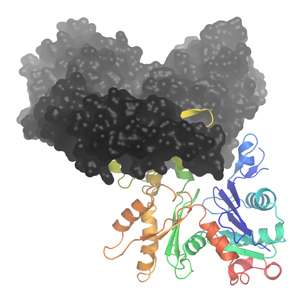Deadly bacterium uses cellular proteins as bait to sabotage a pathway that enables immune response

A protein produced by the pathogen responsible for the bubonic plague sabotages immune detection through a multi-pronged attack, protecting the bacteria as they pursue their deadly mission.
Early in infection, certain immune cells consume pathogens via a process called phagocytosis and subsequently train the immune system to recognize and destroy the invaders. Bacteria have evolved diverse strategies to thwart phagocytosis, several of which target actin—a filament-forming protein that helps drive the pathogen-engulfing process. "Actin is one of the most evolutionarily conserved eukaryotic proteins, and as such is an Achilles' heel for pathogens to attack," explains Robert Robinson of the A*STAR Institute of Molecular and Cell Biology.
Wei Lin Lee, a student in the Robinson laboratory, gained new insights into how Yersinia, the genus of bacteria responsible for the Black Death and other devastating epidemics, disrupts actin assembly. During infection, Yersinia injects a protein called YopO into the immune cells responsible for phagocytosis. YopO binds directly to actin as well as to signaling proteins that promote actin assembly, but also contains an enzymatic domain whose functional importance is unknown.
Lee set out to define this domain's contribution to the infection process. She began with a structural analysis (see image), and determined that YopO binds to actin in a manner that prevents it from forming filaments but leaves it sufficiently exposed to bind to other proteins. The structure also revealed that the enigmatic 'kinase' domain of YopO remains unobstructed in this complex, and can therefore potentially interact with other factors.
Kinases work by tacking phosphate chemical groups onto other proteins, a modification that can switch those targets on or off. Lee subsequently determined that YopO employs bound actin molecules as 'bait', attracting proteins that normally promote actin filament assembly and chemically modifying those targets with its kinase domain.
"I was surprised at the number of proteins that were phosphorylated by this mechanism," says Robinson. For one of those proteins, Lee demonstrated that this modification has an inactivating effect that could inhibit phagocytosis.
These findings show that YopO launches a three-pronged attack on phagocytosis—physically latching onto actin, disrupting signals that control actin assembly and switching off proteins that help actin filaments grow. Robinson notes that antibiotic-resistant plague strains are emerging, and that these results could guide new treatment strategies. A deeper understanding of YopO's targets could also offer new insights into the cellular machinery. "We expect to learn a great deal about the normal control of actin in healthy human cells," says Robinson.
More information: Lee, W. L., Grimes, J. M. & Robinson, R. C. "Yersinia effector YopO uses actin as bait to phosphorylate proteins that regulate actin polymerization." Nature Structural & Molecular Biology 22, 248–255 (2015). dx.doi.org/10.1038/nsmb.2964
Journal information: Nature Structural & Molecular Biology


















